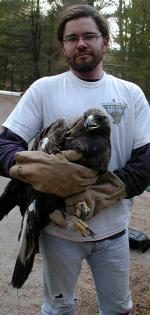 |
|
||||
|
Bald Eagle Migration Update: March 19, 2002
- Get Well Soon! Peter Nye Out for Back Surgery
- While We Wait: Challenge Question #8
- Field Notes from Peter Nye: Before Leaving the Office
- Mark Your Calendar: America's First River: Bill Moyers on the Hudson
- Do Eagles Bite Biologists?
- The Beak: Discussion of Challenge Question #7
- Eagle Adaptations--The Talons: Challenge Question #9
- The Tail: Discussion of Challenge Question #5
Get Well Soon! Peter Nye Out for Back Surgery
Poor Peter Nye went to the hospital last week for back surgery. He expects to be out of his office for 2-4 weeks. He says he?ll forward migration data as soon as he?s feeling better. ?It shouldn't slow down my data-forwarding!? he said before heading out the door. Knowing how captivated by eagles Peter Nye is, we may be back tracking eagles by next week. We apologize for this unexpected change. In the meantime, if you?d like to send him a ?Get Well? card please write to:
Peter Nye
Endangered Species Unit
NYS Dept. Environmental Conservation
625 Broadway
Albany, NY 12233
While We Wait: Challenge Question #8
Each PTT package weighs approximately 100 grams (3.5 oz.), which is less than 2 percent of the body weight of an average adult bald eagle. How would it feel to carry such a backpack?
Challenge Question #8:
"If you wore a backpack that weighed 2% of your body weight, how heavy would your backpack be?"
(To respond to this question, please follow
the instructions below.)
Ready for Take-off? Tips for Analyzing Spring Migration
It?s fun to wonder where the eagles are right now. While you?re waiting for the data to arrive, take time to make your predictions for take off, based on last spring?s data.
- Link to Last Spring?s Take-off Dates
Field Notes from Peter Nye: Before Leaving the Office
Hey All,
?Just got notification of a special TV program I thought I'd pass along. 'America's First River: Bill Moyers on the Hudson,' is a four-hour documentary of the Hudson River that was filmed over the last two years. Several Department of Environmental Conservation staff are included, such as Hudson River fisheries and bald eagle work. It should be quite good, as all Moyer?s productions usually are.?
Mark Your Calendar: April 23 and 24, 9 PM (Eastern Time) on PBS.
?But will YOU be featured?? we asked.
?I don't know about 'featured,' but I think you'll see plenty of me!? said Nye.
Do Eagles Bite Biologists?
?Absolutely, eagles will bite!? he responded immediately. ?It is of grave concern, believe me. I have many scars and chunks out of the backs of my hands to prove it!But they prefer to use their feet.
?The eagles always seem to look so calm, but in reality, holding them is a test of strength and of careful positioning.Once they are firmly gathered up under the arm, securing the feet firmly and containing the wings, are key.(If the wings are loose they will also often use them as weapons to try to beat you.) If they detect 'loose' control, they'll struggle, but if they resist some and sense it is useless, they get the idea and relax a bit.
?Even nestlings are a threat. Their bills are rapier-sharp, needed for quick food ripping from tough fish. They quickly draw blood. The feet and legs of nestlings are usually not yet well-muscled and strong when we band them, so in contrast to the flighted birds, those are not the problem. It is the beaks they use at a young age.?
Pete
Discussion of Challenge Question #7: The Beak
We asked you to take a close look at eagle beaks when we asked, "Why do you think both eagle species have hooked beaks? In your answer, chose at least one other bird and compare its beak to the Bald and Golden eagle beaks."
Jessica, Jessica, Sammy and Martin of Iselin Middle School in New Jersey got together to answer this question. ?Both the Bald Eagle and the Golden Eagle have a hooked beak for tearing their prey for eating.? Then they reminded us, ?They need the hooked beak to eat food because they have no teeth.?
 |
 |
They compared eagles? beaks to robins?: ?The Robins need a small beak because they eat small things such as
worms, seeds, and fruit.?
Jessica of St. Wendelin High School in Ohio compared eagles to a different bird: ?A finch, on the other hand, has
a short, small beak that is very helpful for cracking the seeds it eats.?
Eagle Adaptations--The Talons
Challenge Question #9
 |
Eagle feet, of course, have claws. But so do the feet on dogs, cats, squirrels, raccoons, robins, and even tiny hummingbirds.
What makes eagle feet different? First, the claws must be strong and sharp. When an eagle catches a fish, those claws have to slice into a stiff, strong fish with thick scales protecting its body.
But sharp claws are NOT the reason eagle feet are called talons--after all, cats have sharp claws, too, but they don't have talons. What makes talons different?
Challenge Question #9:
?What?s the difference between claws and talons??
(To respond to this question, please follow the instructions below.)
Discussion of Challenge Question #5: The Tail
We asked you to consider why Bald Eagle?s tails are the way they are. Here?s a fact sheet with labeled photo illustrating the adaptations of the eagle?s tail:
 |
 |
How to Respond to Today's Challenge Questions:
IMPORTANT: Answer only ONE question in each e-mail message.
1. Address an e-mail message to: jn-challenge-eagle@learner.org
2. In the Subject Line of your message write: Challenge Question # 8 (or #9).
3. In the body of EACH message, answer ONE of the questions above.
The Next Bald Eagle Migration Update Will Be Posted on
March 26, 2002
Copyright 2002 Journey North. All Rights Reserved.
Please send all questions, comments, and suggestions to our feedback form










